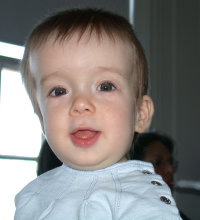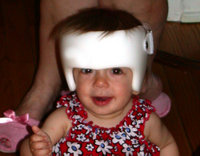Craniosynostosis is the premature closure of one or more of the cranial sutures in a fetus or an infant. The condition was first described by Virchow in 1851 and is estimated to occur in one in 2,000 to one in 2,500 births.[1] A recent rise in the frequency of evaluation for craniosynostosis has been attributed to increased observations of flattening of the malleable infant skull, believed to be related to pressure caused by the supine sleeping position, which was recently recommended to reduce the rate of sudden infant death syndrome (SIDS).[2-4] An upsurge in the frequency of diagnosis of craniosynostosis may represent overdiagnosis and has even spurred comment in such lay publications as the Wall Street Journal.[5]
Illustrative Case
A 41-year-old nonsmoker (gravida 4, para 2) was delivered of a 3,912 g (8 lb, 10 oz) male infant by cesarean section after attempted vaginal delivery failed because of cephalopelvic disproportion. Initially, the infant's malformed head was attributed to molding as a result of the birthing process. At four weeks of age, the misshaping of the skull persisted. Skull radiographs demonstrated fusion of the sagittal suture. A diagnosis of dolichocephalic craniosynostosis (Figure 1) was made. Operative correction was performed when the infant reached two months of age.
[Figure 1 ILLUSTRATION OMITTED]
Pathology and Etiology
The two classifications commonly used to describe craniosynostosis are (1) simple (involving only one suture) or complex (involving more than one suture) and (2) primary (caused by an idiopathic abnormality of bony fusion) or secondary (caused by a variety of systemic or neurologic diseases).[6,7] By definition, primary craniosynostosis is idiopathic. However, data from the Colorado Craniosynostosis Registry suggest that maternal smoking during the prenatal period may increase the risk of primary craniosynostosis.[8]
In 10 to 20 percent of cases of primary craniosynostosis, an associated genetic syndrome is noted. Craniosynostosis has been associated with more than 50 inherited syndromes, the most common of which are Crouzon's disease (craniofacial dysostosis, type II), Apert's syndrome (acrocephalosyndactyly, type I), Carpenter's syndrome (acrocephalopolysyndactyly, type II), Saethre-Chotzen syndrome (acrocephalosyndactyly, type III) and Pfeiffer syndrome (acrocephalosyndactyly, type V).
The craniosynostosis syndromes may have similar etiologies.[9] Pfeiffer and Jackson-Weiss syndromes are caused by a mutation in fibroblast growth factor receptor 1. Similarly, craniofacial dysostosis is now known to be associated with a mutation in fibroblast growth factor receptor 2. Thus far, four mammalian fibroblast growth factor receptors and nine fibroblast growth factors have been discovered. It is possible that other craniosynostosis syndromes have a molecular basis.
Subtypes
The terminology used to describe primary craniosynostosis is based on the suture involved (Figure 2). Scaphocephaly, the most common subtype, results from fusion of the sagittal suture. It is characterized by a long narrow skull, a prominent occiput and a broad forehead. Scaphocephaly is more common in males than in females, and it is believed to be sporadic in inheritance. It can cause cephalopelvic disproportion during birth (as in the illustrative case), and it is the type of craniosynostosis least likely to be associated with other genetic defects.
[Figure 2 ILLUSTRATION OMITTED]
Frontal plagiocephaly, the second most common subtype of craniosynostosis, results from fusion of a coronal and sphenofrontal suture. Occipital plagiocephaly results from fusion of the lambdoidal suture. Occipital plagiocephaly often results from the stereotyped positioning of an immobile (i.e., disabled) child. It is the type that is most likely to occur in a child who is not disabled and who is kept in the supine position during the day as well as the night.
Many cases of what appears to be occipital plagiocephaly are deformations rather than true craniosynostoses,[4] because there is no true fusion of the suture.[2,3]
Trigoncephaly, a rare form of craniosynostosis, results from fusion of the metopic suture. Turricephaly results from fusion of the coronal, sphenofrontal and frontoethmoidal sutures. Kleeblattschadel refers to a cloverleaf deformity of the skull and is associated with hydrocephalus.
Terms that may be used to describe craniosynostosis include "dolichocephaly," indicating a long narrow skull, and "brachycephaly," indicating a short, wide skull. Neither term relates to the etiology of the disorder.
Secondary craniosynostosis may result from a failure of brain development (microcephaly) or from systemic conditions, such as prematurity, rickets, hypophosphatemia, hyperthyroidism, the mucopolysaccharidoses, and diseases that result in severe anemia, such as thalassemia.[6,7]
Diagnosis
The differential diagnosis of craniosynostosis includes molding that occurs during birth, cephalohematoma, intracranial tumor, hydrocephalus, inherited benign macrocephaly and positional molding, which is sometimes referred to as deformational plagiocephaly or plagiocephaly without synostosis (Table 1).
Treatment
The treatment of craniosynostosis is primarily surgical, and the patient should be referred to a center with an experienced pediatric neurosurgical or pediatric craniofacial surgical team. Most authors suggest correction of all cases of true craniosynostosis, including cases in which a single suture is involved. Early surgery is recommended, although correction of complex or secondary craniosynostosis may require multiple procedures.[13] Complication rates for postoperative hydrocephalus, shunt placement and seizures have been reported as 3.8 percent, 1.0 percent, and 2.9 percent, respectively.[14,15] Leptomeningeal cysts are a rare complication of skull surgery.
Positional molding should be prevented by periodic changes in the infant's daytime position; treatment has included use of head bands and helmets.[16] Head bands and helmets require individual fitting and should be provided at a pediatric tertiary care center after pediatric neurologic or neurosurgical consultation. Kane and colleagues[2] have developed an algorithm that includes surgical treatment for cases of plagiocephaly without synostosis in which conservative treatment fails. In one study of patients with deformational plagiocephaly,[3] 73 percent improved with frequent head turning, 23 percent required helmet treatment and 4 percent required surgery. In another study,[4] 6 percent required surgery; helmet therapy was found to be more effective if it was initiated before the child reached six months of age.
Final Comment
Women who are planning a pregnancy should be counseled to stop smoking, because this intervention may decrease the frequency of occurrence of craniosynostosis. The infant's position should be changed frequently during waking hours, usually from the back to one side or the other, or prone. During sleep, the infant should be placed on his or her back, and the position of the head should be changed periodically to the right, left or neutral position.[17] While family physicians can recognize craniosynostosis, care should be taken in making the diagnosis of occipital plagiocephaly since positional molding may mimic this rare form of craniosynostosis.
REFERENCES
[1.] Menkes JH. Malformations of the central nervous system. In: Taeusch HW, Ballard RA, Avery ME, eds. Schaffer and Avery's diseases of the newborn. 6th ed. Philadelphia: Saunders, 1991.
[2.] Kane AA, Mitchell LE, Craven KP, Marsh JL. Observations on a recent increase m plagiocephaly without synostosis. Pediatrics 1996;97:877-85.
[3.] Turk AE, McCarthy JG, Wisoff JG. The "back to sleep campaign" and deformational plagiocephaly: is there cause for concern? J Craniofac Surg 1996;7:12-8.
[4.] Argenta LC, David LR, Bell WO. An increase in infant cranial deformity with supine sleeping position. J Craniofac Surg 1996;7:5-11.
[5.] Ortega B. Unkind cut some physicians do unnecessary surgery on heads of infants. Wall Street Journal 1996 Feb 23;Sect. A:1 (colt 1).
[6.] Marion RW. Craniosynostosis. Pediatr Rev 1995;16:115-6.
[7.] Haslam RH. Congenital anomalies of the central nervous system. In: Nelson WE, Behrman RE, Kliegman RM, Arvin AM, eds. Nelson textbook of pediatrics. 15th ed. Philadelphia: Saunders, 1996.
[8.] Alderman BW, Bradley CM, Greene C, Fernbach SK, Baron AK. Increased risk of craniosynostosis with maternal cigarette smoking during pregnancy. Teratology 1994;50:13-8.
[9.] Davies K. Receptor malfunction. Nature 1994; 372:202.
[10.] Cohen MM Jr, Pruzansky S. Craniosynostosis: diagnosis, evaluation, and management. New York: Raven Press, 1986.
[11.] Thorkelsson T, Mimouni F, Ball WS Jr, Wood BR Radiological case of the month. Sagittal and lambdoidal craniosynostosis. Am J Dis Child 1992; 146:1311-2.
[12.] Pilgram TK, Vannier MW, Marsh JL, Kraemer BB, Rayne SC, Gado MH, et al. Binary nature and radiographic identifiability of craniosynostosis. Invest Radiol 1994;29:890-6.
[13.] Marsh JL, Vannier MW, Pilgram TK. Craniosynostosis: diagnostic imaging with three-dimensional CT presentation. Am J Neuroradiol 1994; 15:1861-9.
[14.] McCarthy JG, Glasberg SB, Cutting CB, Epstein FJ, Grayson BH, Ruff G, et al. Twenty-year experience with early surgery for craniosynostosis: II. The craniofacial synostosis syndromes and pansynostosis--results and unsolved problems. Plast Reconstr Surg 1995;96:284-95, discussion 296-8.
[15.] McCarthy JG, Glasberg SB, Cutting CB, Epstein FY, Grayson BH, Ruff G, et al. Twenty-year experience with early surgery for craniosynostosis: I. Isolated craniofacial synostosis--results and unsolved problems. Plast Reconstr Surg 1995;96:272-83.
[16.] Clarren SK. Plagiocephaly and torticollis: etiology, natural history, and helmet treatment. J Pediatr 1981;98:92-5.
[17.] Hunt CE, Puczynski MS. Does supine sleeping cause asymmetric heads? Pediatrics 1996;97:127-9.
The Author
FLOYD L. MCINTYRE M.D. is in private practice at Cape Cod Hospital, Hyannis, Mass. He earned a medical degree from the University of Oklahoma School of Medicine, Oklahoma City, and completed a residency in family medicine at the University of Connecticut School of Medicine in Farmington.
Address correspondence to Floyd L. McIntyre, M.D., 76 Airline Rd., South Dennis, MA 02660.
The author thanks Nancy Frazier for her research assistance in the preparation of the manuscript.
COPYRIGHT 1997 American Academy of Family Physicians
COPYRIGHT 2004 Gale Group




